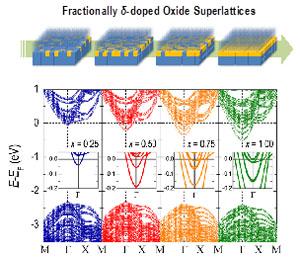
Chemistry and Physics at Interfaces
"Fractional δ-doping," i.e. the use of single-unit-cell thick layers of a solid-solution complex oxide, is shown to effectively change the electron effective mass in the LaxSr1-xTiO3/SrTiO3 superlattice system. This adds another degree of freedom in tuning physical properties of complex oxides, in particular those related to two-dimensional electron gases (2DEGs), and will aid in the development of new materials needed for next generation high-speed microprocessors with low power consumption, displays, and portable electronic devices. In this work, a d-band electron filling effect was observed, in which the electron effective mass and the density of the charge carriers are sensitive to compositional changes within layers just one unit cell thick and stacked in various LaxSr1-xTiO3/SrTiO3 superlattices. Fractional-layer modulation of the interface’s chemical composition gives rise to changes in the degree of electronic reconstruction, thereby being an effective way to controlling transport properties. Density functional theory calculations explain the experimentally observed changes in transport properties of the 2DEGs and illustrate how this design strategy ultimately adds another degree of freedom in designing oxide-based heterostructures.
For more information, please contact Woo Seok Choi, choiw@ornl.gov
Woo Seok Choi, Suyoun Lee, Valentino R. Cooper, and Ho Nyung Lee, “Fractionally δ-doped oxide superlattices for higher carrier mobilities,” Nano Letters 12, 4590 (2012).

